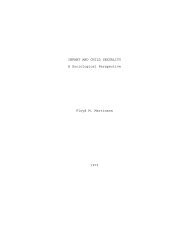1 Social Response to Age-Gap Sex Involving Minors ... - Ipce
1 Social Response to Age-Gap Sex Involving Minors ... - Ipce
1 Social Response to Age-Gap Sex Involving Minors ... - Ipce
You also want an ePaper? Increase the reach of your titles
YUMPU automatically turns print PDFs into web optimized ePapers that Google loves.
4<br />
then only 3 out of 100 with CSA do. This is a very small difference and dramatically contradicts<br />
the expected 70 or 80 out of 100 that comes from standard therapeutic discourse and media<br />
hype. 6 In our most comprehensive meta-analysis, we examined 5 dozen college samples, with<br />
results identical <strong>to</strong> the national samples. 7 The more extensive college data permitted causal<br />
analyses that suggested that very little of the increase from 2 <strong>to</strong> 3 out of 100 could be attributed<br />
<strong>to</strong> the CSA. The increase instead was associated mostly with poorer family and peer<br />
environments in the CSA samples. The results also showed wide differences in reactions <strong>to</strong> CSA<br />
by boys versus girls: two-thirds of boys responded positively or neutrally, whereas two-thirds of<br />
girls responded negatively. In short, the meta-analyses strongly contradicted the standard picture<br />
of CSA by using more representative samples and more precise methods of analysis. As a<br />
footnote, many advocacy groups were furious at our meta-analysis of college studies, eventually<br />
prompting the US Congress <strong>to</strong> condemn it in 1999. But 10 years hence, despite intense scrutiny,<br />
our results stand solid. 8<br />
To be sure, there are many who have had negative CSA encounters and have been<br />
disturbed by them—these are the ones who tend <strong>to</strong> come <strong>to</strong> the attention of clinicians. What is<br />
important <strong>to</strong> note, though, is that many others, in response <strong>to</strong> episodes that fall under the standard<br />
definition of CSA, have not been bothered by them at all or have even reacted positively and<br />
remember them well. This information is available in numerous non-clinical, non-forensic<br />
6 Rind, B., & Tromovitch, P. (2007). National samples, sexual abuse in childhood, and adjustment in adulthood: A<br />
commentary on Najman, Dunne, Purdie, Boyle, and Coxeter (2005). Archives of <strong>Sex</strong>ual Behavior, 36, 101-106.<br />
7 Rind, B., Tromovitch, P., & Bauserman, R. (1998). A meta-analytic examination of assumed properties of child<br />
sexual abuse using college samples. Psychological Bulletin, 124, 22-53.<br />
8 See, for example: American Psychologist (2002). Interactions among scientists and policymakers: Challenges and<br />
opportunities. Vol. 57, March; Rind, B., Tromovitch, P., & Bauserman, R. (2001). The validity and appropriateness<br />
of methods, analyses, and conclusions in Rind et al. (1998): A rebuttal of victimological critique from Ondersma et<br />
al. (2001) and Dallam et al. (2001). Psychological Bulletin, 127, 734-758; and Rind, B. (2006). Meta-analysis, moral<br />
panic, congressional condemnation, and science: A personal journey (pp. 163-193).. In D. Hantula (ed.) Advances in<br />
social & organizational psychology: A tribute <strong>to</strong> Ralph Rosnow. Hillsdale, NJ: Erlbaum.
















